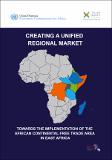- Introduction: Nalishebo Meebelo, Senior Program Coordinator, Regional Network of Agricultural Policy Research and Institutes (ReNAPRI)
- David Laborde Debucquet, Senior Research Fellow, IFPRI
- Maryla Maliszewska, Senior Economist, World Bank Group
- Andrew Mold, Chief, Regional Integration and AfCFTA Cluster, Office for Eastern Africa, ECA, UNECA
- Closing Remarks: Antoine Bouet, Senior Research Fellow, IFPRI
- Moderator: Julie Kurtz, Research Analyst, IFPRI
Resources
The World Bank report, WB (2020) The African Continental Free Trade Area: Economic and Distributional Effects, (163 pp) is designed to guide policymakers in implementing policies that can maximize the agreement’s potential gains while minimizing risks. Creating a continent-wide market will require a determined effort to reduce all trade costs. Governments will also need to design policies to increase the readiness of their workforces to take advantage of new opportunities.- COVID-19 has caused major disruptions to trade across the continent, including in critical goods such as medical supplies and food.
- By increasing regional trade, lowering trade costs and streamlining border procedures, full implementation of AfCFTA would help African countries increase their resiliency in the face of future economic shocks and help usher in the kinds of deep reforms that are necessary to enhance long-term growth.
AfCFTA offers big opportunities for development in Africa, but implementation
will be a significant challenge. This analysis identifies key priorities for African policy makers. Lowering and eliminating tariffs will be the relatively easy part—even if
it comes, in some cases, with the challenge of how to replace tariff revenues. The hard
part will be enacting the nontariff and trade facilitation measures, which is where the
Overview 9
analysis predicts the largest potential economic gains. Such measures will require substantial policy reforms at the national level, indicating a long road ahead. Achieving
AfCFTA’s full potential depends on agreeing to ambitious liberalization and implementing it in full. Partial reforms would lead to smaller effects. (page 9)
 Creating a unified regional market : towards the implementation of the African, continental free trade area in East Africa. Addis Ababa. © UNECA - United Nations. Economic Commission for Africa 140 pp.
Creating a unified regional market : towards the implementation of the African, continental free trade area in East Africa. Addis Ababa. © UNECA - United Nations. Economic Commission for Africa 140 pp.This East Africa report is fruit of a partnership between TradeMark East Africa and ECA’s sub-regional office for Eastern Africa – two organisations that share a pan-African vocation and the conviction that greater intra-regional trade and investment is the way forward.
A particular challenge for agriculture is the persistence of non-tariff barriers (NTBs). NTBs that
commonly impact on agricultural trade, such as sanitary and phytosanitary measures (SPS), have
become progressively more important than tariffs, and tend to be higher than in non-agricultural sectors
(UNCTAD, 2016b and Kee et al., 2009). SPS measures alone have been estimated to raise domestic prices
of foodstuffs by about 13 percent in sub-Saharan Africa. (page 73)
The perishable nature of many agricultural food
products means that their trade could be particularly
responsive to improvements in customs clearance times
and logistics, which are expected from AfCFTA implementation (ECA, AUC and AfDB, 2017). Moreover,
East Africa’s agricultural sector is characterized by an inadequate use of yield-enhancing practices and
technologies. With the AfCFTA in place, access to agricultural inputs and intermediates (e.g. improved
seed varieties and machinery) should improve, thereby raising yields and enhancing food productivity. (page 74)
Agro-processing generates a
high rate of profitability in the region. However, as it currently stands, African agribusinesses have to
compete with large international conglomerate firms (that tend to be based in developed countries)
under unfavourable terms in the global agricultural markets. These firms set the ‘rules of the game’ –
mostly due to their ability to create powerful brand names and enforce standards – and relegate the
African farmers and SMEs to the position of “standard
takers” who are excluded from important value-creating
processes. (page 74)


No comments:
Post a Comment